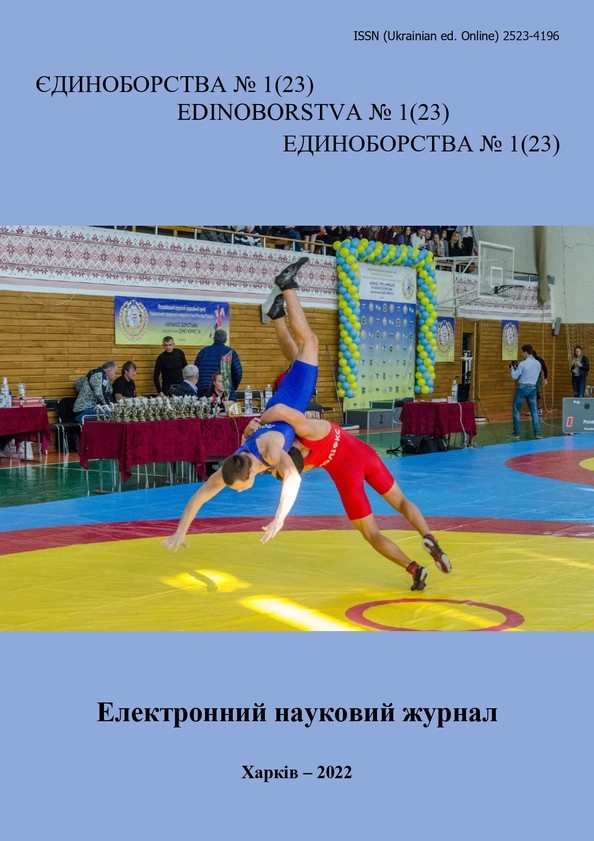Дослідження морфометричних показників і пальцевого індексу 2D:4D в аспекті статевого диморфізму у представників карате
DOI:
https://doi.org/10.15391/ed.2022-1.01Ключові слова:
статевий диморфізм, пальцевий індекс, карате, морфометричні показникиАнотація
Мета: вивчити пальцевий індекс, антропометричні і морфометричні данні в аспекті статевого диморфізму у каратистів обох статей 11-22 років. Матеріал і методи. В дослідженнях брали участь 106 хлопчиків і юнаків у віці від 11 до 22 років, а також дівчаток і дівчат у віці від 11 років до 22 року (n=101). Здійснювалося вимірювання довжини 2-го і 4-го пальців обох рук від внутрішнього краю базального гребеня в підставі пальця до кінчика пальця як у юнаків, так і у дівчат-каратисток (за J.T. Manning). Методи
дослідження: аналіз науково-методичної літератури; антропометричні та морфометричні дослідження; методи математичної статистики. Результати: використання методики визначення пальцевого індексу «2D:4D» є доступною і простою в застосуванні, і активно використовується як один з інформативних критеріїв маскулінізації жіночого організму в спорті. В процесі проведення досліджень каратистів нами виявлено, що найбільше представництво спортсменок з пальцьовими пропорціями за чоловічим типом було в групі дівчат старше 16 років (70 %). У спортсменок, що займаються карате у віці 12-15 років, значення пальцевого індексу, відповідні чоловічому типу, зустрічалися в 45 % випадків (0,98±0,07, коефіцієнт варіації CV=4,82 %), що свідчить про підвищення рівня тестостерону. У контрольній групі неспортсменок пальцевий індекс 0,996±0,04, CV=3,92 %. За показниками індексу Рорер (ІР) ваго-ростові значення каратистів: астенічний (торакальний) тип статури у 28 % випробовуваних, атлетичний (м'язовий) – у 38 % і дігестивний (пікничний) – у 34 %. Висновки. Проведене дослідження показало, що за даними
пальцевого індексу у спортсменок-каратисток 16-22 років переважають особи з генетично детермінованою маскулінізацією. За показниками статевого диморфізму у дівчат виявлено помірні і легкі ознаки будови тіла протилежної статі. На підставі отриманих результатів дослідження доповнені наявні дані про особливості фізичного і статевого розвитку
каратистів обох статей 11-22 років, що дає можливість в підвищенні якості планування тренувального процесу спортсменів.
Посилання
Балакничев, М.Г., Врублевский, Е.П., & Мирзоев, О.М. (2007). Отбор и подготовка спортсменок в легкой атлетике с позиции полового диморфизма. Теория и практика физической культуры, 11-15.
Бугаевский, К.А. (2017). Особенности показателей маскулинизации студенток, занимающихся физической культурой. Физическая культура, спорт и здоровье в ВУЗе, 47-51.
Бугаевский, К.А., Черепок, А.А., & Волох, Н.Г. (2017). Исследование особенностей ряда морфологических и репродуктивных значений спортсменок, занимающихся танцевальным спортом. Наука-2020, 5 (16), 38-44.
Бутовская, М.Л., Буркова, В.Н., & Феденок, Ю.Н. (2015). Пальцевой индекс как индикатор пренатальной андрогенизации и его связь с морфологическими и поведенческими характеристиками человека. Этнографическое обозрение, № 2, 99-116.
Вілянський, В.М., & Бачинська, Н.В. (2019). Особливості психофізіологічних показників висококваліфікованих спортсменів з урахуванням статевого диморфізму (на прикладі карате та спортивної акробатики). Єдиноборства, № 4 (14), 36-37.
Кочеткова, Е.Ф., & Опарина, О.Н. (2014). Особенности и проблемы полового диморфизма в cпорте. Современные научные исследования и инновации, № 7, 17-19.
Лопатина, Л.А., Сереженко, Н.П., & Анохин, Ж.А. (2013). Антропометрическая характеристика девушек по классификации Дж. Таннера. Фундаментальные исследования, № 12-3, 504-508.
Мандриков, В.Б., Самусев, Р.П., & Зубарева, Е.В. (2013). Влияние занятий спортом на соматические показатели полового диморфизма у девушек разных типов конституции. Вестник Волг ГМУ, № 2 (46), 17-19.
Олейник, Е.А. (2009). Пальцевые пропорции у спортсменок, занимающихся спортивными видами единоборств как маркер морфологической маскулинизации. Ученые записки университета им. П.Ф. Лесгафта, № 8 (54), 96-98.
Ткачук, М.Г., & Дусенова, А.А. (2015). Половой диморфизм и его в спорте: монография. М.-Берлин: Директ-Media.
Brown, W.M., Finn, C.J., & Breedlove, S.M. (2002). Sexual dimorphism in digit-length ratios of laboratory mice. Anat. Rec, 267, 231-234.













